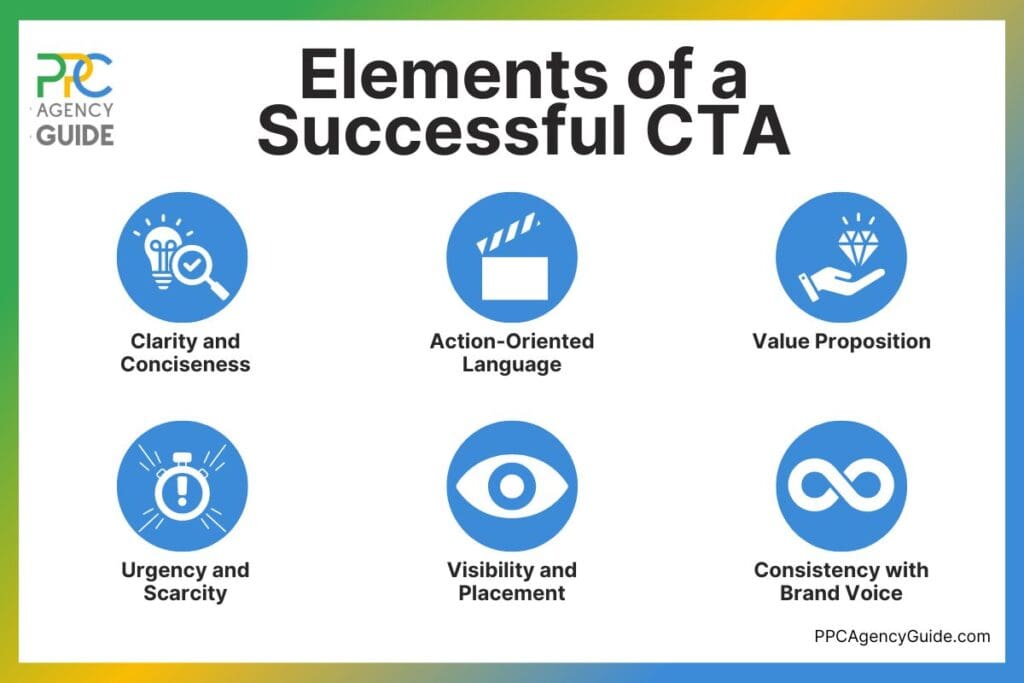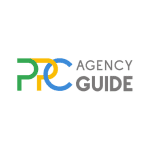
Did you know that ads with a compelling call to action (CTA) can be 200 percent better at generating clicks than one without? These short phrases used in your ad copy and landing pages can dramatically transform PPC results, yet many businesses overlook them when developing in-house campaigns. On this page, we’ll walk you through how and why CTAs work to engage your audience, provide some tried-and-true examples, and give you a roadmap so it’s easier to start developing irresistible CTAs on your own.
The Importance of Call-To-Actions in PPC Advertising
Call-to-actions are a crucial component of PPC advertising. They serve as the bridge between capturing a user’s interest and driving them to take the desired action, whether that’s making a purchase, signing up for a newsletter, or downloading a resource.
- Directing User Behavior: CTAs provide clear instructions on what you want the user to do next. Without a CTA, users might be left uncertain about the next steps, leading to lower engagement and conversion rates.
- Creating Urgency: Phrases like “Buy Now,” “Limited Time Offer,” or “Get Started Today” create a sense of urgency, encouraging users to act immediately rather than postponing their decision. This urgency can significantly increase the likelihood of conversions.
- Enhancing User Experience: Well-crafted CTAs guide users smoothly through the purchasing journey, improving their overall experience. When users know exactly what to do next, they are more likely to have a positive interaction with your brand.
The Role of CTAs in User Engagement
CTAs are pivotal in engaging users by:
- Grabbing Attention: Effective CTAs stand out and grab the user’s attention amidst the plethora of online ads. This is often achieved through compelling language, contrasting colors, and strategic placement.
- Fostering Interaction: By prompting users to take specific actions, CTAs foster interaction with your ad. This interaction is the first step towards deeper engagement with your brand.
How CTAs Can Boost Your Click-Through Rates
- Clarity and Relevance: A clear and relevant CTA resonates with users, aligning with their needs and interests. For instance, a CTA like “Download Your Free eBook” directly addresses users looking for educational resources. By zeroing in on personalized CTAs that align with the buyer’s journey and resonate with the person’s interests, brands can boost clicks by 202 percent, HubSpot reports.
- Testing and Optimization: Regularly testing different CTAs can reveal what resonates most with your audience. Simple changes in wording, color, or placement can lead to significant improvements in CTR. For instance, A/B tests show red CTA buttons typically outperform green ones, despite the fact that red is usually viewed as a warning or negative color, HubSpot research shows.
- Value Proposition: Your CTA should communicate a clear value proposition. Users need to understand what’s in it for them if they click. A strong value proposition CTA, such as “Get 50% Off Your First Purchase,” can dramatically increase CTR by appealing directly to the user’s interests.
Creating Effective Call-To-Actions
Now that we’ve covered the background, let’s explore the components that make a CTA effective, along with the role of color psychology and design in crafting compelling CTAs.
Elements of a Successful CTA

- Clarity and Conciseness: A successful CTA is clear and to the point. It tells users exactly what action they need to take in a concise manner. For instance, phrases like “Sign Up Now” or “Get Started” leave no ambiguity about what the user should do next.
- Action-Oriented Language: Use strong, action-oriented verbs that prompt immediate action. Words like “Download,” “Register,” “Join,” and “Discover” are more effective than passive language. For example, “Download Your Free Guide” is more compelling than “Click Here for More Information.”
- Value Proposition: Communicate the benefit the user will receive by taking the action. This could be a discount, free trial, or access to exclusive content. A CTA like “Get 20% Off Your First Order” clearly conveys the value to the user.
- Urgency and Scarcity: Incorporating elements of urgency or scarcity can motivate users to act quickly. Phrases like “Limited Time Offer,” “Only a Few Left,” or “Act Now” create a sense of urgency that can drive immediate action.
- Visibility and Placement: The CTA should be prominently placed and easy to find. Ensure that the CTA stands out and is positioned where users’ eyes naturally go, such as the top half of a webpage or within the main body of an ad.
- Consistency with Brand Voice: Your CTA should align with your overall brand voice and messaging. This consistency helps build trust and makes the CTA feel like a natural extension of your brand.
Color Psychology and CTA Design
- Color Selection: Colors evoke different emotions and reactions. The right color choice can significantly impact the effectiveness of your CTA. Here are some examples:
- Red: Creates a feeling of immediacy and excitement. It’s great for CTAs like “Buy Now” or “Limited Time Offer.”
- Green: It is associated with growth, safety, and prosperity. It’s often used for CTAs related to financial products or services, like “Start Saving.”
- Blue: Conveys trust and security. It’s a good choice for CTAs in the tech or healthcare industries, such as “Learn More” or “Get Started.”
- Contrast and Readability: The CTA should stand out from the background and other elements on the page. A high contrast between the CTA button and the surrounding area makes it more noticeable. For example, a bright orange button on a white background draws attention more effectively than a muted color.
- Size and Shape: The size of the CTA button should be large enough to grab attention but not so large that it overwhelms the other content. Rounded corners are often preferred as they are seen as more inviting compared to sharp edges. A well-sized and appropriately shaped button makes the CTA more clickable.
- Whitespace: Surrounding the CTA with whitespace can help it stand out and draw focus. Crowding the CTA with too many other elements can dilute its impact. Adequate spacing ensures that the CTA is the focal point.
- Button Text: The text on the CTA button should be large enough to read easily and should clearly convey the action. Use bold fonts to enhance readability and emphasis.
Writing Persuasive Text for Your CTAs
Writing persuasive text for your CTAs is crucial in driving user engagement and conversions. Next, we’ll explore the key components of crafting action-oriented language and the power of persuasive words in PPC ads.
Action-Oriented Language That Converts
- Use Strong Verbs: The core of any effective CTA is the use of strong, direct verbs that tell users exactly what to do. Action-oriented language cuts through any ambiguity and propels the user towards taking a specific step. Examples include:
- “Download“: For offering a resource, e.g., “Download Your Free eBook.”
- “Register“: For event sign-ups, e.g., “Register for the Webinar.”
- “Get“: For accessing a benefit, e.g., “Get 50% Off Today.”
- Be Specific: Specificity helps users understand exactly what they will get by clicking the CTA. Instead of vague terms like “Click Here,” use phrases that detail the benefit or action, such as “Start Your Free Trial” or “View Pricing Plans.”
- Create a Sense of Urgency: Adding a time element to your CTA can prompt immediate action. Phrases like “Buy Now,” “Limited Time Offer,” or “Start Today” can create a sense of urgency that nudges users to act without delay.
- Highlight the Benefit: Users are more likely to click if they see a clear benefit. Phrasing your CTA in a way that highlights what they will gain can make a significant difference. For example, “Get Your Free Guide” emphasizes the value of the offer.
The Power of Persuasive Words in PPC Ads
- Emphasize Value: Words that highlight value can make your CTA more compelling. Terms like “Free,” “Exclusive,” “Limited,” “Instant,” and “Guaranteed” convey strong benefits that attract clicks. For instance, “Get Instant Access” suggests immediate gratification.
- Use Emotional Triggers: Emotional words can create a deeper connection with users. Words like “Save,” “Discover,” “Unlock,” and “Enjoy” can evoke positive emotions, making the CTA more appealing. An example is “Unlock Exclusive Content.”
- Incorporate Social Proof: Including words that imply social proof can boost the credibility of your CTA. Phrases like “Join Thousands,” “Trusted By,” or “Proven” leverage the influence of other users’ positive experiences. For example, “Join Over 10,000 Happy Customers.”
- Convey Exclusivity: People are often drawn to exclusive offers. Words like “Only,” “Exclusive,” and “Members-Only” can make users feel special and prompt them to act. A CTA like “Get Your Exclusive Offer” suggests a unique opportunity.
Adjusting CTAs for Different Audiences
Tailoring your CTAs for different audiences and consistently testing them are key strategies for maximizing the effectiveness of your PPC ads. Below, we’ll walk you through how to adjust CTAs for various market segments and the importance of A/B testing.
Customizing Your CTAs for Various Market Segments
- Understand Your Audience: Start by thoroughly understanding the demographics, psychographics, and behavior patterns of your target audience. This knowledge helps you create CTAs that resonate with specific segments. For instance, a younger audience might respond better to CTAs with more casual and trendy language, while a professional audience might prefer formal and straightforward CTAs.

- Tailor the Language: The language of your CTA should reflect the preferences and needs of different audience segments. For example:
- Tech-Savvy Audience: “Start Your Free Trial” or “Download Now.”
- Budget-Conscious Audience: “Save 20% Today” or “Get a Free Quote.”
- Health-Conscious Audience: “Join Our Wellness Program” or “Get Healthy Recipes.”
- Address Specific Pain Points: Customize your CTAs to address the unique pain points of each segment. For instance, a CTA for a time-strapped professional might be “Save Time with Our Service,” while a CTA for a small business owner could be “Boost Your Sales Today.”
- Use Relevant Imagery and Design: The visual design of your CTA, including images, colors, and fonts, should also cater to different segments. Younger audiences might prefer bold colors and dynamic designs, while older audiences might appreciate more subdued and professional aesthetics.
A/B Testing: Finding the Right CTA for Your Audience
- Define Your Variables: A/B testing involves comparing two versions of a CTA to determine which one performs better. Define the variables you want to test, such as wording, color, placement, or size. For instance, you might test “Get Started Now” versus “Start Your Free Trial” to see which phrase drives more clicks.
- Run Controlled Experiments: Ensure that you run controlled tests where only one element is changed at a time. This isolation helps you identify the specific factor that influences the performance of your CTA. Use A/B testing tools available in ad platforms like Google Ads or Facebook Ads to streamline this process.
- Measure Performance Metrics: Track key performance metrics such as click-through rates (CTR), conversion rates, and bounce rates to evaluate the effectiveness of each CTA variant. This data will help you determine which CTA resonates best with your audience.
- Iterate and Optimize: Use the insights gained from A/B testing to continuously refine and optimize your CTAs. The goal is to find the best-performing version and then keep experimenting with new variations to stay ahead of changing audience preferences.
Integrating CTAs into Your PPC Strategy
Integrating CTAs effectively into your PPC strategy is crucial for ensuring a seamless and persuasive user experience. This includes aligning your CTAs with your ad copy and landing page, as well as continually improving and optimizing them. Let’s explore these elements in detail.
Aligning Your CTA with Your Ad Copy and Landing Page
- Consistency in Messaging: Consistency across your ad copy, CTA, and landing page is vital. If your ad copy promises a specific benefit, your CTA and landing page should reflect that promise. For example, if your ad copy says, “Get 50% Off Your First Order,” your CTA should be something like “Claim Your Discount,” and the landing page should prominently feature the discount offer.
- Relevance to User Intent: Ensure that your CTA is relevant to the user’s intent and the search query that led them to your ad. For example, if a user searches for “free marketing tips,” a CTA like “Download Free Marketing Guide” aligns well with their intent and increases the likelihood of a click.
- Seamless User Journey: The transition from an ad to a landing page should be smooth. The CTA in your ad should lead to a landing page where the action can be completed easily. If the CTA in your ad is “Sign Up Now,” the landing page should prominently feature a sign-up form above the fold.
- Visual and Textual Harmony: Maintain a cohesive visual and textual design between your ad and the landing page. Use similar colors, fonts, and imagery to create a unified experience. This consistency builds trust and reassures users that they are in the right place.
- Clear and Prominent Placement: Your CTA should be clear and prominently placed on the landing page. Users should not have to scroll or search for the next step. A clear and visible CTA button near the top of the page, with additional buttons placed strategically throughout, can improve conversion rates.
Continuous Improvement and Optimization of Your CTAs
- A/B Testing: As mentioned earlier, A/B testing is essential for continuous improvement. Regularly test different CTA variations to see what works best. This includes testing different wording, colors, sizes, and placements. For instance, you might test “Get Started Today” versus “Join Now” to see which performs better.
- Analyze Performance Metrics: Use analytics tools to track the performance of your CTAs. Key metrics to monitor include click-through rates (CTR), conversion rates, and bounce rates. Analyzing these metrics helps you understand what’s working and what needs improvement.
- User Feedback: Collect and analyze user feedback to gain insights into how users perceive your CTAs. This feedback can come from surveys, user testing sessions, or direct feedback from customers. Use this information to refine and enhance your CTAs.
- Stay Updated with Trends: Digital marketing trends evolve, and what worked yesterday might not work tomorrow. Stay updated with the latest trends and best practices in PPC advertising and CTA optimization. For example, incorporating interactive elements like chatbots or dynamic CTAs can be a trend worth exploring.
- Adapt to Seasonal Changes: Adjust your CTAs based on seasonal trends and events. During holiday seasons, CTAs like “Shop Holiday Deals” or “Get Your Gift Now” can be more effective. Tailoring your CTAs to current events or seasonal promotions keeps your ads relevant and timely.
Tips for Effective Integration
- Use Analytics Tools: Leverage tools like Google Analytics, Hotjar, and other PPC platforms’ built-in analytics to monitor and optimize your CTAs. These tools provide insights into user behavior and performance metrics.
- Iterative Approach: Adopt an iterative approach to optimization. Continuously test, learn, and refine your CTAs to adapt to changing user behaviors and preferences.
- Engage in Competitive Analysis: Analyze your competitors’ PPC strategies and CTAs. Understanding what works for them can provide valuable insights and inspiration for your campaigns.
Put Your PPC Calls to Action on Autopilot
CTAs are crucial for driving user engagement and conversions, so they must be well-polished to effectively capture attention and prompt action. An agency can ensure your CTAs are effective by using clear, action-oriented language, conducting A/B testing, and continuously optimizing based on performance data. PPC Agency Guide can connect you with skilled agencies that specialize in crafting compelling CTAs, ensuring you maximize your ROI through expert strategies and proven methodologies tailored to your unique needs. To take the next step, request a complimentary consultation.
PPC Call to Action FAQs
Why are CTAs important in PPC campaigns?
CTAs are vital in PPC campaigns because they direct user behavior, create urgency, and enhance user engagement. A well-crafted CTA provides clear instructions, making it easier for users to understand the next steps. Effective CTAs can significantly boost click-through rates (CTR) and conversions, directly impacting the success and ROI of your PPC campaigns.
How can I create effective CTAs for my PPC ads?
To create effective CTAs, use clear and concise language with strong action verbs like "Download," "Register," or "Get Started." Highlight the value proposition to show users what they gain by clicking. Incorporate urgency with phrases like "Limited Time Offer." Ensure your CTA is visually prominent and aligns with your ad copy and landing page for a seamless user experience.
What elements should be included in a successful CTA?
A successful CTA includes clear and concise language, a strong action verb, a compelling value proposition, and a sense of urgency. It should be visually distinct, using contrasting colors to stand out, and placed prominently to catch the user’s attention. Consistency with the overall ad and landing page design is also crucial for effectiveness.
How does color psychology influence CTA design?
Color psychology plays a significant role in CTA design by evoking specific emotions and reactions. For example, red can create a sense of urgency, green signifies growth and safety, and blue conveys trust and security. Choosing the right color can make your CTA more attractive and compelling, encouraging users to take the desired action.
What are some examples of persuasive words to use in CTAs?
Persuasive words in CTAs include "Free," "Now," "Instant," "Exclusive," "Limited," "Save," and "Discover." These words highlight value, create urgency, and evoke positive emotions, making the CTA more enticing. For instance, "Get Instant Access" or "Claim Your Free Trial" can significantly boost user engagement and conversion rates.
How can I tailor my CTAs for different audience segments?
Tailor CTAs by understanding the specific needs and preferences of each audience segment. Use language and benefits that resonate with them. For example, a younger audience might respond to "Join Now," while professionals might prefer "Start Your Free Trial." Customize the design and placement to match the browsing behavior of each segment.
What is A/B testing and how can it improve my CTAs?
A/B testing involves creating two versions of a CTA to see which performs better. By changing one element at a time, like wording or color, you can identify what resonates most with your audience. Continuous A/B testing helps refine and optimize CTAs, leading to higher click-through rates and conversions, ultimately improving your PPC campaign’s effectiveness.
How do I align my CTA with my ad copy and landing page?
Align your CTA with your ad copy and landing page by ensuring consistency in messaging, design, and user experience. The promise made in your ad should be fulfilled on the landing page, and the CTA should clearly guide users to the next step. This seamless integration builds trust and increases the likelihood of conversion.
Why should I hire a PPC agency to optimize my CTAs?
Hiring a PPC agency ensures your CTAs are optimized by professionals who understand the nuances of effective ad campaigns. They use data-driven strategies, A/B testing, and industry best practices to create compelling CTAs that maximize click-through rates and ROI. A skilled agency can tailor CTAs to your audience, ensuring higher engagement and conversions.


















